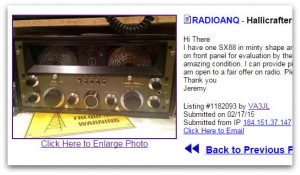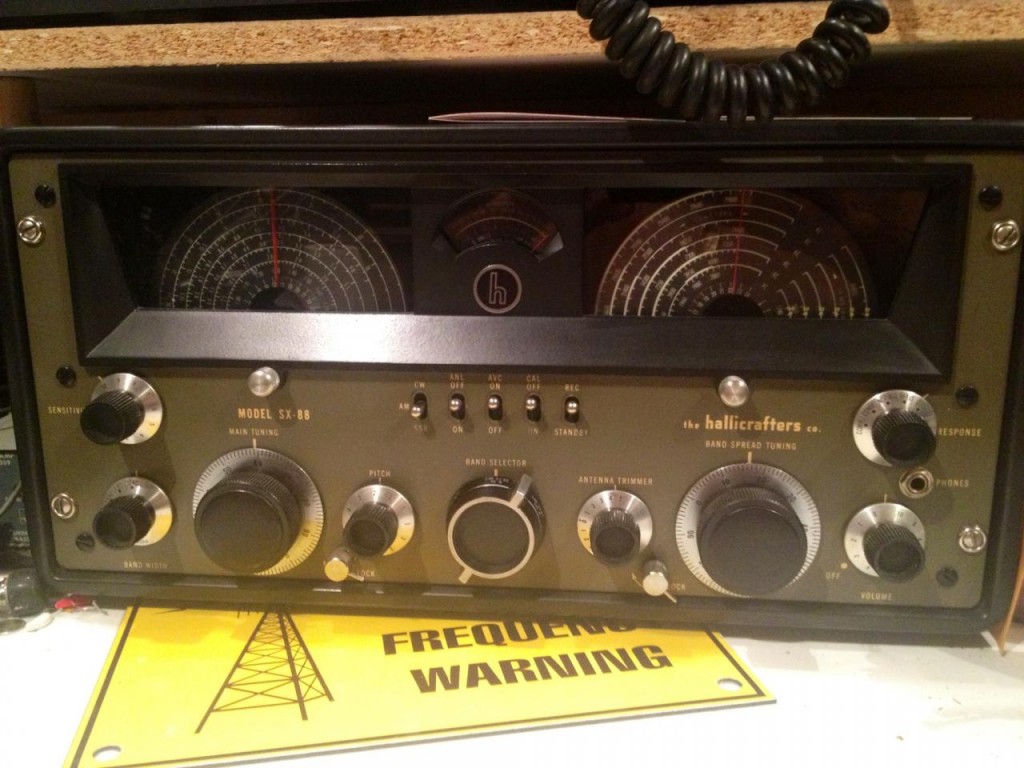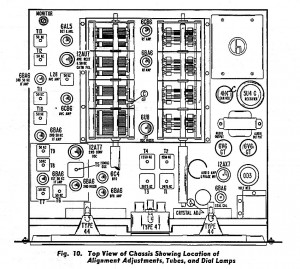Archive for the ‘hamradio’ Category
 What happens to your gear when you die?
What happens to your gear when you die?
How’s that for a title? I’m helping a widow sell her late husband’s ham gear. Things are going quickly as a local ham bought most of the newer gear based on recent sale prices from eBay and the QRZ.com swapmeet forum. Had she not reached out to the local club, it’s likely she would have sold thousands of dollars of gear at a yard sale for pennies, or simply sent it to recycling.
This got me to thinking…does my wife know who to call to dispose of my gear should something happen to me? While probably not high on the things to do list if I pass suddenly, it sure would be a good idea to have a list of hams I trust in a folder for her.
There are some great hams out there – I met another one over email this week who spends hundreds of dollars a year to provide data services for other hams. But there are also crooks and thieves that would rob a widow blind. Do your significant other a favor…leave behind a list of hams you trust.
 When Good Caps Go Bad
When Good Caps Go Bad

I’ve been helping out the guys in Springfield, IL get the W9DUA DSTAR gateway back up and running. We were successful reviving it after some Linux magic and Google-foo I performed a few weeks ago. We did notice that the server would reboot occasionally. Weird, but hey this is amateur radio not public safety.
After a few more hiccups it was time to investigate. Steve, K9CZ brought the server to me to take a closer look. After putting it on the bench and doing some more testing, I got to the point where I could scare it into a reboot on demand. Nothing in the logs, memory was properly seated, Dell diagnostics all passed, and reverting the last OS patch didn’t help.
Hmmm….looking around some more…I found these four capacitors on this Dell SC440 motherboard. Yep, they are toast. Something bad has happened in this server’s past. I yanked the hard drive and have it in a new machine now…after some more testing it should be back up and running by the weekend.
When capacitors go bad, bad things happen.
 WAS most wanted?
WAS most wanted?
This weekend I finally snagged Nevada. Not one of the smallest states in the US, but certainly one that has been elusive to me since getting back into HF in 2013. I had worked a ham in Nevada earlier last year, but my multiple requests for LoTW or a paper card fell into the noise. But this weekend I worked a Nevada station that promised a paper card straight away.
This got me to thinking…with the magic list of DXCC most wanted, is there a WAS most wanted list? I worked every state and received quick confirmations in short order except for Delaware and Nevada. And watching the psk streams go by, I sure see a lot of people asking for NV, and DE. Of course, it depends on where you’re located.
 The Hallicrafters SX-88: a rare find and a gem of engineering
The Hallicrafters SX-88: a rare find and a gem of engineering
[Note: this post first appeared on my shortwave radio blog, the SWLing Post.]
Yesterday while glancing through the QTH.com classifieds ads, I noticed a rare boat anchor for sale: the Hallicrafters SX-88.
The seller, Jeremy, describes this SX-88 as follows:
Hi [t]here, I have one SX88 in minty shape and is one of a handful that came in military green on [the] front panel for evaluation by the military. This is an exceptional radio in amazing condition. I can provide pics for someone who is seriously interested. I am open to a fair offer on radio. Please, no low-ballers. We all know what [it’s] worth…
 “We all know what it’s worth“–?
“We all know what it’s worth“–?
Well, it just so happened that my good friend (and Elmer, or ham radio guru) Mike Hansgen (K8RAT) had recently provided me with a little history lesson on the subject of the SX-88, so I did know what this rig is worth: a great deal of money.
But curiosity got the best of me, so I contacted Jeremy (a nice fellow, by the way) and asked what he was expecting to receive in exchange for his Hallicrafters SX-88? Jeremy’s reply:
“…$5,500 USD will take it. It is a very rare unit; it was… only one of about 6 [painted green]…for presentation to the military for evaluation.
That price is firm. [I] will not negotiate downward, and shipping [from Ontario, Canada] is extra.”
After receiving this response from Jeremy, I happened to think that I have the reference guide to rare/used shortwave receivers: Fred Osterman’s Shortwave Receivers Past and Present 4th edition. (Click here for more info.)
Osterman’s wonderfully comprehensive guide mentions that the SX-88 is a “highly regarded, rare and collectible model.” As for the rarity of the SX-88, he describes it thus: “Extremely Scarce.” The used price range he gives is from $3,500-7,000 US.
I also have Chuck Dachis’ book, Radios By Hallicrafters; in it, he states that the SX-88 is, “the most sought-after Hallicrafters model.” Wow.
After thanking Jeremy for his response, he replied:
“It’s a lot of money for a receiver for certain, but it is a fantastic shortwave receiver as the audio that comes out of it is amazing.
It has 10 watts of audio and into a big speaker–it is second to none. The fidelity is amazing and it is the king of its kind. [For those who like] tube rigs, it is the best of its kind.
For ham purposes on AM it is amazing, and on CW I find it incredible to use.
[W]hen they built this thing they intended to pull all [the] stops out and build the best radio they could for the day with the military in mind. It was an engineering marvel for the day.
Anyway, I have played with it for years now and need to thin out the herd.”
Impressive. And while I just don’t have that kind of money to fork out for a receiver, I did ask myself the question: “If I had $5,500 to blow, would I get that Hallicrafters SX-88?”
And my answer? Yes. In fact, I would personally drive to Jeremy’s home in Ontario and bring it back; no way I’d trust it to a parcel carrier or the post office…
Come on, you may say. For a guy who rarely pays over $50 for a vintage receiver, how could you possibly justify that kind of financial and time commitment–?
Well, let’s think of it this way. I remember when when I paid well over two thousand for my first laptop in college. How much is it worth now? Maybe twenty dollars–?
Many people have retirement funds in investments, some of which are in a variety of innovative companies that they actually patronize–for example, Apple or Microsoft. But how often can you find an investment that you can actually play with? One which you can turn on, tune in, work the controls, and enjoy?
Yes, I’m sure this is just the sort of justification voiced by many a vintage car collector…So, why not for a museum-worthy radio? After all, they’re not making these anymore.
I expect this Halli will not only hold its value, but will probably increase in value over time.
Ah, well; fun to ponder. My question to you: Would you buy a $5,500 vintage receiver if you had it to spare?
If your answer is yes, and you do have the money, then you might want to contact Jeremy.
I’m very curious if there are any SX-88 owners among our readership? If so, please comment with your thoughts about the ’88!
And for the rest of us, just so we can revel in the vicarious pleasure of ownership, I’ve included some additional information about the Hallicrafters SX-88 below, including two videos.
Resources (courtesy of Jeremy):
[youtube http://www.youtube.com/watch?v=ozclVUwZ_mM]
[youtube http://www.youtube.com/watch?v=clF5HsewTnU]
 KN0WCW – working the FISTS USA Club
KN0WCW – working the FISTS USA Club
I’m back up and running on HF after getting purchasing a very lightly used KX3 from Elecraft to replace my smoked radio! The radio arrived last Wednesday and I was back on the air that night. I’ve made a few casual contacts using various digital modes. I even worked K1N late in the week with 12 watts with CW on 20M. While not truly QRP, it does show that you don’t need a kilowatt to bust a pileup!
Also a notable contact was with KN0WCW/2 – that’s KNOW CW – the club call for the FISTS CW Club NA Chapter. Cody was the operator of the night from 2 land. I was slightly embarrassed even answering his call…my CW is rookie level at best, even with the great keyer on the KX3. I couldn’t get the /2 to come out right no matter what I did! Cody hung in there with me and we had a nice QSO. I didn’t keep him too long so he could log some more. Good job there Cody!
 A Fun Weekend
A Fun Weekend
The weekend started with a great surprise on Friday at lunchtime. My good friend Dennis KE9UA invited me over to his QTH to try to work K1N. Dennis is a serious DXer. The picture above shows the gorgeous SteppIR in his backyard. This picture was taken as I headed out after working K1N on my first call. Yep, barefoot at 100 watts on 20m. What a hoot! I smiled the rest of the weekend, and I’m smiling now writing this three days later.
Saturday morning brought me back to the big city to take a look at the WX9WX dstar machine. Coverage wasn’t as good as expected, and because of the great logging of the G4KLX software I could see that we had a problem. The duplexer we were using wasn’t providing enough isolation, resulting in receiver desense. I usually check this when building a new system but somehow forgot this step this time. A quick swap to a much better duplexer and the problem was solved.
Sunday was a day of rest…church then grilling of steaks, took a nap, then tinkered in the barn until it was too cold to be outside. A nice 2M net with friends on the Clinton IL repeater rounded out a fun weekend. I love this hobby!
 It’s dead, Jim.
It’s dead, Jim.
| My “first” KX3 during its early days at KG9DW. |
I heard back from Elecraft yesterday, and my KX3 is officially toast. You see, it wasn’t ever designed to have 120VAC applied to the external power connector. As I feared, the current transitioned through the control board, wiped out some components, traveled across the leads to the RF board, took out multiple components, and then exited through the well grounded antenna connection.
Talking through the options, fixing it is cost prohibitive. The guys at Elecraft are working on an option for me, so I’m hopeful I’ll have a working KX3 back in the shack in the next couple of weeks. In the meantime, I’ve got a loaner radio from a buddy in the shack. It transmits fine but its receiver is so, so deaf compared to the KX3. It’s like going from an iPad Air to a Palm Pilot.
In the comments of my last post about this mistake, the suggestion of fusing along with a diode was brought up. I’ll definitely be putting more thought into my power supply cables after this costly error.














